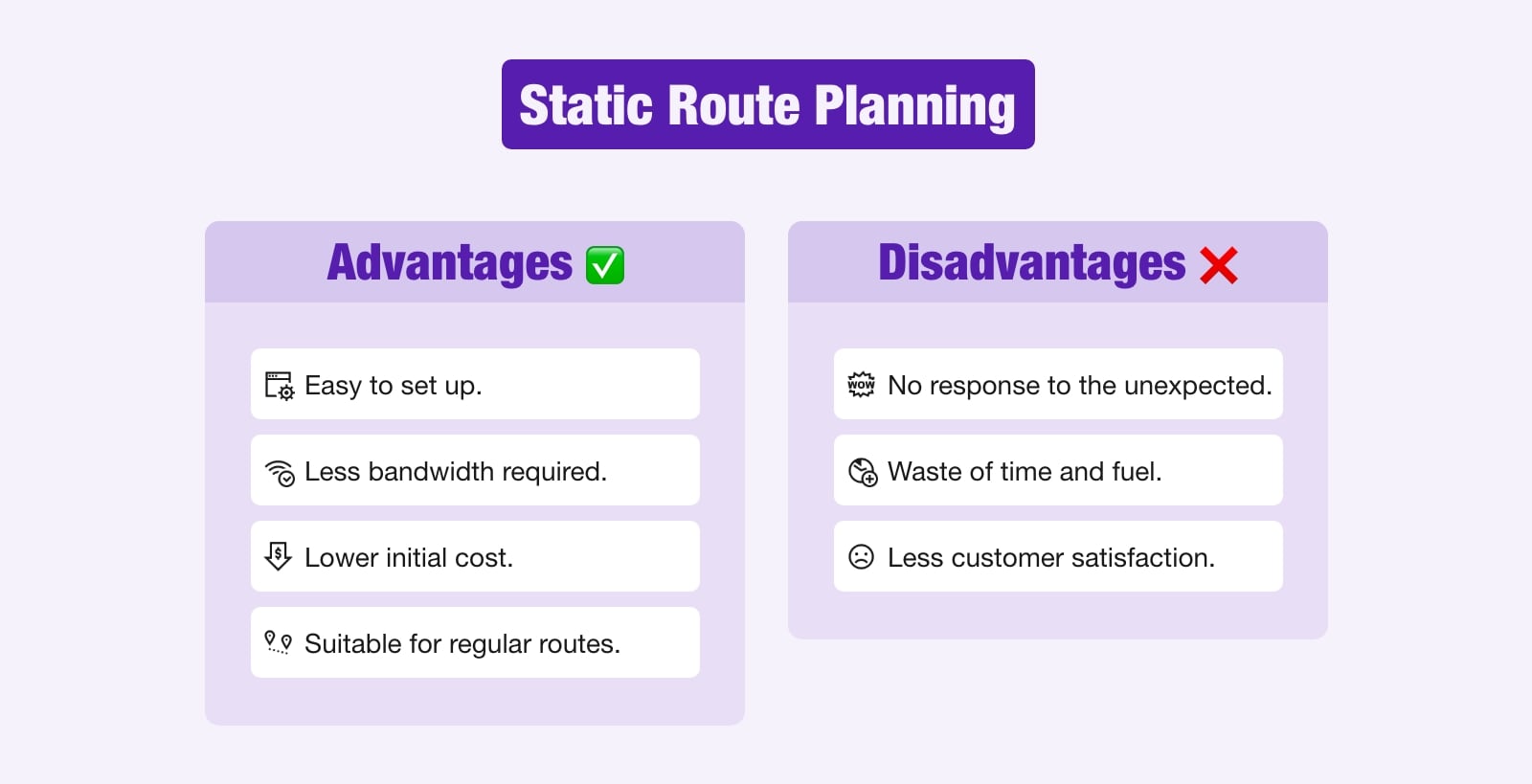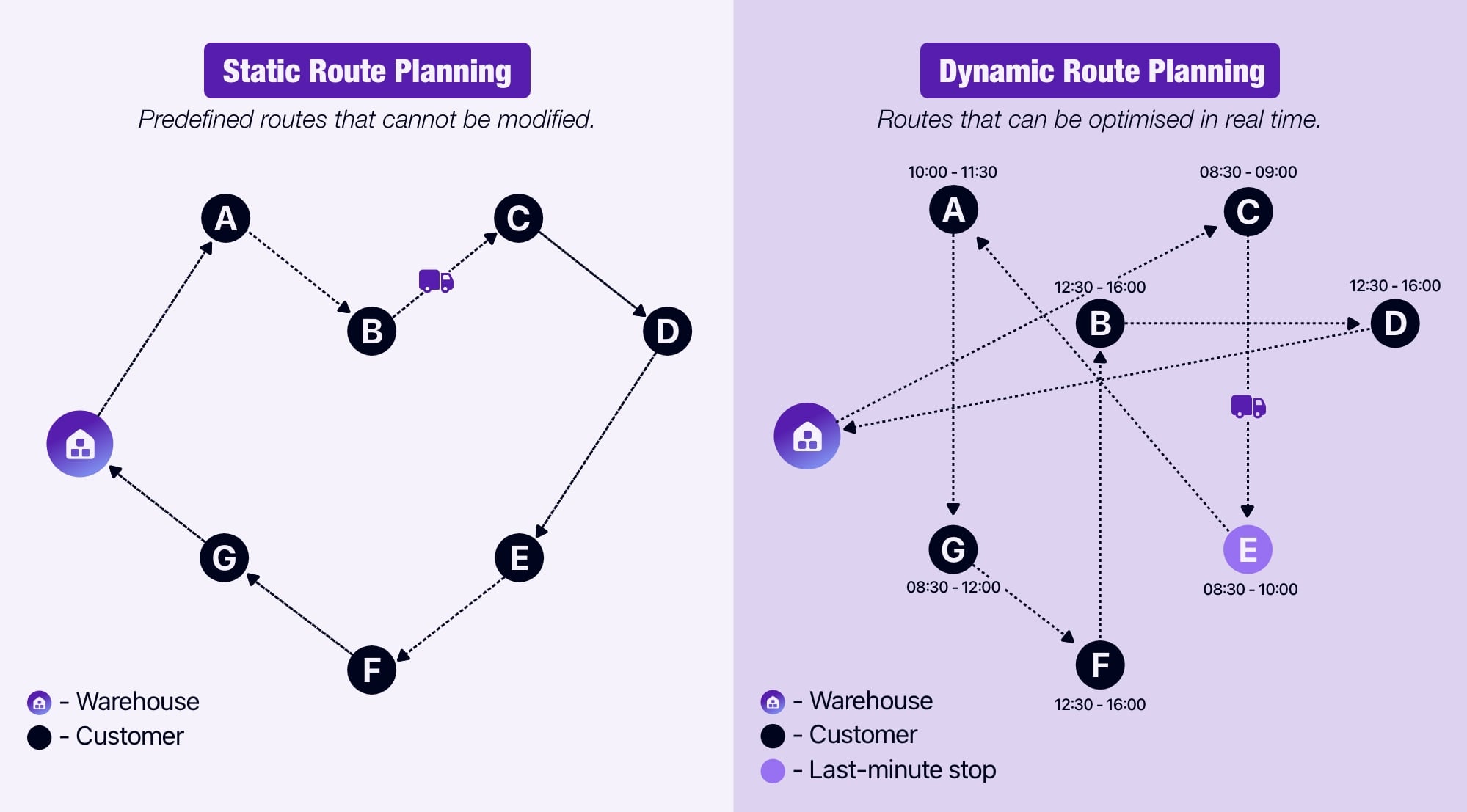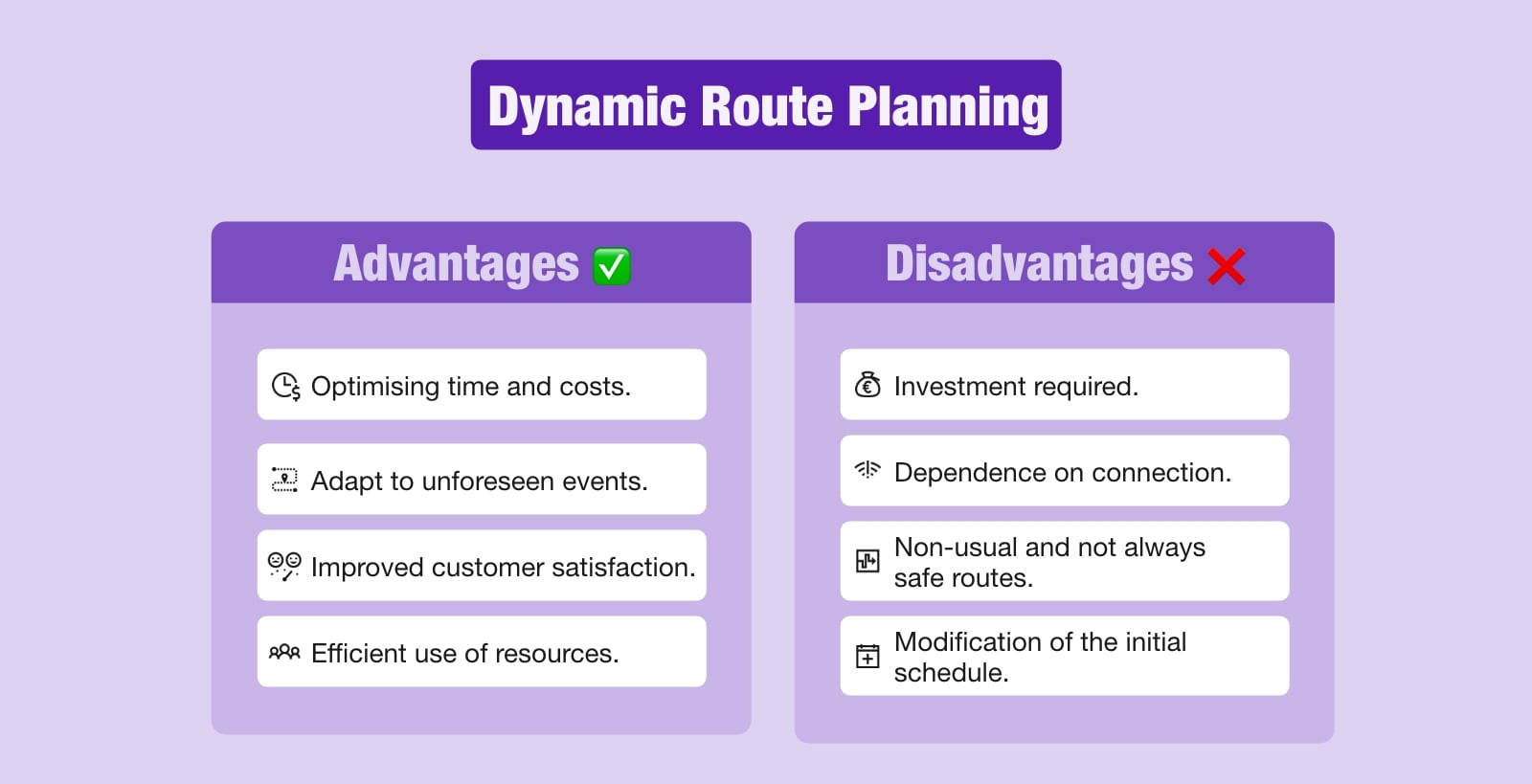Static Route Planning vs. Dynamic Route Planning – Which One Should you Choose?

Whether you manage a fleet of delivery lorries, a team of field technicians or home care activities, the way you plan your routes has a direct impact on your costs, productivity and customer satisfaction.
Many companies traditionally use a static planning method: their routes are defined in advance and do not change once they have been validated. But dynamic planning technologies are becoming more and more accessible, and are establishing themselves as an effective and flexible alternative.
So what do these two route planning methods mean? Which one should you choose? And how can you combine the best of both? We explain everything in this article.
Table of contents:
- Static route planning: simple and secure, but rigid
- Dynamic route planning: more flexible and efficient
- So which route planning system should you choose?
Static route planning: simple and secure, but rigid
How does static route planning work?
Static planning consists of defining routes in advance, with no possibility of modifying them in real time. The delivery schedule, together with the corresponding times and routes, is generally unchanged from one day to the next. It may be modified periodically, but is always drawn up by the day before at the latest. Once planned, the routes never change.
This method is simple and reliable, with predictable and safe routes. It is often carried out using a simple spreadsheet or free planning software.
Here’s a concrete example:
Every Friday, a meal delivery service plans the coming week’s delivery routes to nursing homes. The delivery locations and times are generally identical from one week to the next. The drivers have a fixed itinerary and follow the same route, whether it’s raining or there’s traffic jam, regardless of the exact number of meals to be delivered.

The advantages and disadvantages of static route planning.
Advantages of static planning
✅ Easy to set up: No need for complex software, a simple spreadsheet can do the trick.
✅ Less bandwidth required: Static scheduling does not require a continuous internet connection, which is ideal in poorly served areas.
✅ Lower initial cost: No major investment in technology tools.
✅ Suitable for regular routes: Ideal if your customers are fixed and have recurring schedules.
Static route planning is, however, less flexible and not always the most appropriate for your business.
Here are 3 disadvantages of static planning
❌ No response to the unexpected. An accident, a closed road, an absent customer, a stop to be added? Impossible to readjust the route in real time.
❌ Waste of time and fuel. Without an optimised route in real time, you increase fuel consumption, CO2 emissions and time spent on the road at the same time, to the detriment of other deliveries or field service operations.
❌ Less customer satisfaction. Not being able to adjust deliveries or field service operations to demand can damage customer satisfaction, tarnish the company’s image and complicate the management of emergencies, such as care or critical breakdowns.

Static vs. dynamic route planning.
Dynamic route planning: more flexible and efficient
How does dynamic route planning work?
Dynamic route planning uses technological tools such as software, GPS and algorithms to adjust routes in real time.
Dynamic routes take into account various parameters such as the type, volume and duration of deliveries or operations. The route and order of stops are adjusted according to this data to optimise efficiency.
If you need to deliver heavy items to the 5ᵉ floor, this data will be able to be integrated automatically into the planning. Similarly, if you need to carry out three treatments instead of two, or if you have twice as many meals to deliver that day to the same location, these elements will be taken into account.
But dynamic planning doesn’t stop there.
It also takes account of unplanned parameters:
- Live traffic updates: traffic jams, accidents, road closures.
- Order changes: last-minute additions or cancellations.
- Customer priorities: emergencies or specific time slots.
The aim is to optimise each journey to reduce costs, delays and CO2 emissions, while guaranteeing a high level of customer satisfaction and taking account of unexpected factors such as road traffic and emergencies.
Here’s a concrete example:
A lift maintenance service uses optimisation software with dynamic route planning. When an emergency arises, the system automatically reschedules the rest of the day’s appointments. This enables the service to be scheduled just before another service in the same geographical area, thereby reducing journey times and increasing productivity.

The advantages and disadvantages of dynamic route planning.
Advantages of dynamic planning
✅ Optimising time and costs: reducing the number of kilometres driven and fuel consumption.
✅ Adapt to unforeseen circumstances. Driver stuck in traffic? The route is recalculated in real time.
✅ Improved customer satisfaction. Deliveries are faster and more accurate.
✅ Efficient use of resources: fewer immobilised vehicles, less time wasted.
But dynamic planning is not without its drawbacks
❌ Investment required: Switching to dynamic scheduling generally involves using a premium solution and therefore a minimum investment, in addition to team training.
❌ Dependence on connection: In the event of connection difficulties, adjustments may be blocked, with a risk of downtime or unsuitability. Not to mention the fact that all the data has to be integrated into the software before you can start your route.
❌ Non-usual and not always safe routes. Depending on the nature of the goods or the areas crossed, adopting new routes can pose a problem. In addition, digital data may be exposed to security risks.
❌ Modification of the initial schedule: Although beneficial for adapting continuously, this flexibility can lead to a loss of control over predefined schedules and routes.
Comparison Table: Static vs. Dynamic Planning
| Criteria | Static planning | Dynamic planning |
| Predictability | Strong | Variable |
| Security | Known and safe routes | Risks of data interception and connection dependency |
| Adapting to the unexpected | Low | Excellent |
| Flexibility | Limited | High |
| Technological costs | Low | Medium |
| Operational efficiency | Medium | Optimised |
| Customer satisfaction | Medium | High |
So which route planning system should you choose?
The choice between static and dynamic planning depends on your specific needs:
- Static planning is preferred if your itineraries and schedules are stable, with regular customers and few changes in your activities. It is particularly suited to areas where the internet connection is weak or non-existent.
- Opt for dynamic planning if your flows are variable, with urgent requests or fluctuating traffic conditions. You’ll gain in flexibility, productivity and customer satisfaction.
The good news? You don’t have to choose exclusively between the two. Many software packages combine these two models.
- Use dynamic planning for irregular or urgent routes.
- Keep static planning for recurring routes or areas where connectivity is limited.
At AntsRoute, we offer hybrid solutions tailored to your needs. Our licences start from just 17 euros per vehicle per month, offering affordable, high-performance route optimisation.
Whether you’re a fleet manager, logistics manager or technical team leader, the choice between static and dynamic scheduling should be guided by your priorities: stability and simplicity on the one hand, flexibility and efficiency on the other. By understanding the advantages and limitations of each method, you can optimise your routes for better customer service and controlled costs.
WRITTEN BY

Maryline Lakh
Maryline worked for a major logistics company for 15 years. Since 2022, she has been an expert in communication and freelance writer for positive-impact logistics companies. She is passionate about new sustainable logistics solutions and writes for several clients, including AntsRoute.
Free 7-day trial | No credit card required
Contenu
- Static route planning: simple and secure, but rigid
- How does static route planning work?
- Advantages of static planning
- Here are 3 disadvantages of static planning
- Dynamic route planning: more flexible and efficient
- How does dynamic route planning work?
- Advantages of dynamic planning
- But dynamic planning is not without its drawbacks
- So which route planning system should you choose?





